Making the Paul Sellers’ cane – getting started
Starting out a business – the first steps may well begin here
You may well see this as a starting point to a home-based business and I hope that that is the case for you. Learning to make them by hand will give a greater understanding and feel for the process and will give you greater levels of skill and fulfilment than using machines. I will however give the process for making them by machine when I am done with this training series. That way you can meet the higher demands should your business grow into a manufacturing enterprise.
Upcoming cane-making series with woodworkingmasterclasses.com
Another thing. Those of you who are members of woodworkingmasterclasses.com may want to hold off starting your cane until next Wednesday 30 October when we start the new online broadcast series for making canes, sticks and staffs. This will actually show the techniques and methods more clearly than I can do here.

The blank sizes are 23mm x 50mmx 175mm long (7/8” x 2” x 7”) for the handle and 23mm x 35mm x 965mm (7/8” x 1 3/8” x 38”) long for the shaft or stem.
The tools you will need are square, knife, pencil, mortise gauge, 1/4”*, 3/8” and 1” chisel, chisel hammer, tenon saw, plane, spokeshave, hand ripsaw, hand router*, rasp.
*Denotes non-essential tools.
1: To begin, lay out the taper on the stick shaft. The stick tapers from 35mm to 22mm (1 3/8” to 7/8”), regardless of the length you make your cane.
2: Rip down the length with the ripsaw cutting on the waste side of the line and leaving sufficient to plane down to the line.
3: Plane the edge straight and square.
4: Square a shoulder line around the shaft a little more than the width of the handle after being cut to shape but before any rounding over is done. This is done at the wide end of the shaft, which is obviously the top of the cane. Use the square and the knife and remember the cane tapers, so you must decide on a face to register the square against and stick to it.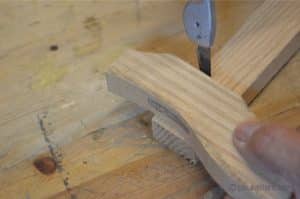
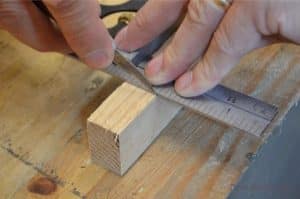
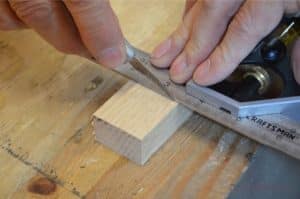
5: Set the mortise gauge to a 10mm (3/8”) chisel and, centred in the 22mm (7/8”) face so that the distance is equal from both sides, run the gauge lines along both edges and onto the end grain. This setting will work for both the shaft tenon and the handle mortise.
6: Chisel into the knifewalls on the waste side to further delineate the shoulder line.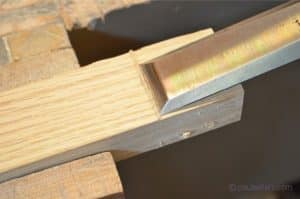
7: Saw down these shoulder lines to the cheek of the tenon.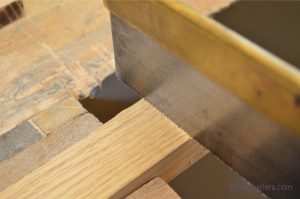
8: Now saw down the gauge lines to establish the cheeks of the tenon.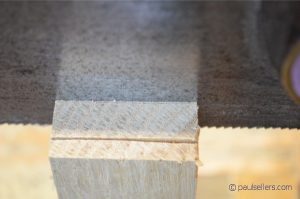
9: Trim the shoulders with the 1” chisel to remove any fibres and level the shoulders.
Mortising the handle
10: I like to shape the handle before I mortise as this makes the mortise less deep. Draw out the shape as show onto the handle blank.
11: Make saw cuts down to near the lines and chisel away the waste. Take care to follow the grain and use wisdom in determining which direction the grain runs.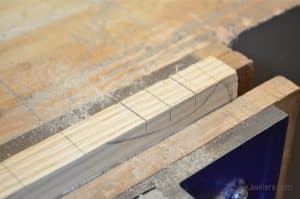
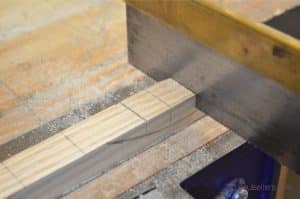

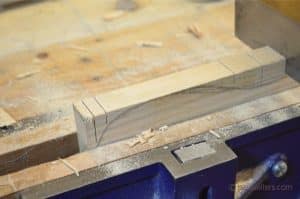
12: Now use the 1″ wide chisel to remove the waste wood.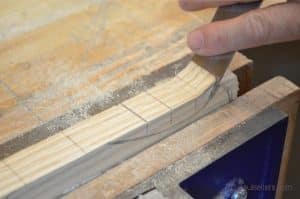
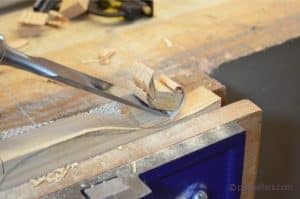

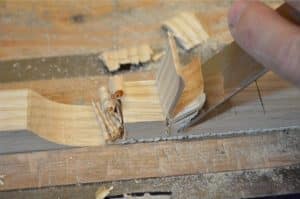
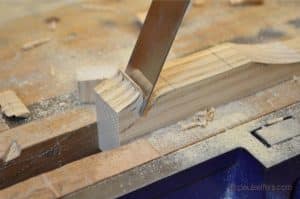
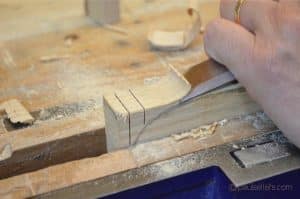
You may want to use a coping saw for direct crosscut work near the rounded end.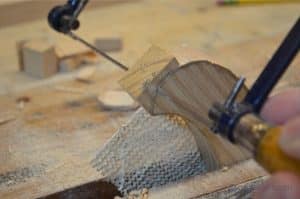
Measure 30mm (1 1/4”) from the end of the handle and make a mark. Use the actual shaft to get the exact distance for the second line. These lines are not accurate but they serve as temporary lines to show where to start and stop the gauge lines.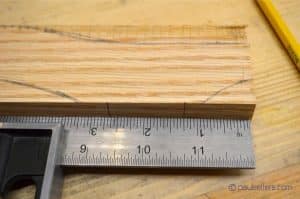
13: Using the same mortise gauge used for the tenon, mark gauge lines onto the narrow edges of the handle and between the pencil lines.
14: Chop out the mortise hole working from both sides and meeting somewhere in the mid section. 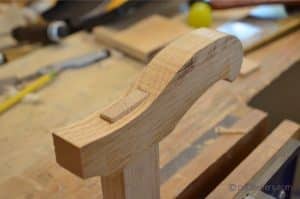
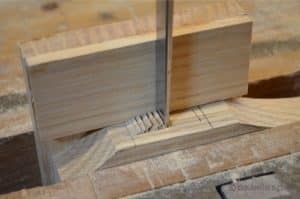
More soon.


This is great timing Paul!
My Dad will be 91 in December, he was stationed in England and flew missions over France and Germany back in WWII. He continued to serve in the US Air Force for 22 years before retiring. Tomorrow morning he is going into surgery for a hip replacement. So I will make one of these for him this weekend, I am sure it will come in handy for him during his recovery.
Thanks again
Steve Follis
Good luck to your dad.
hi Paul im just about to visit Auriou rasps site which rasp would you recommend for these canes as i dont yet have any
Eddy – Theres a nice, 4-in-1 rasp made by Auriou that Paul mentions here:
https://paulsellers.com/2013/07/aurou-rasps-good-on-the-wood-and-good-in-the-hand/
He mentions the 4-in-1 as a good alternative to getting the set of chairmaker’s rasps, which are much costlier. At $89 its not cheap, but when you consider you get 4 rasps in one, its pretty good deal. I just got it and am getting ready to try it out (need to adjust my workspace still). The rasp is quite small looking but looks high quality and to be about right for just about any shaping task you can imagine. Carlos J. Collazo
That’s a good answer Carlos.
Glad to be of help
– Carlos
thanks Carlos i will take a look
I have used several of theAuriou offering now and the one I go to use by that maker is the 10″ #9 cabinet rasp. I am not saying that there are no other makers that parallel Auriou quality but it is a good all round rasp.
Like Crance, I will be making a cane for my dad. I was wondering, is ash an acceptable species of wood to use? I would imagine it is, but want to make sure since the cane will be used daily. Also, I have an ash board on hand and wouldn’t have to go out for a a new board of white oak.
Ash makes an excellent cane, Dan. It takes stain and dye well too, so you can add colour if you think it’s needed.
Can you explain how the handle on the hiking staff is joined? I want very much to make one and as I could guess at the joinery I would rather be sure as the strength of the joint seems important to the staff.
Mortise and tenon joint. 3/8″.
Thanks for the reaponse! I have been thinking about it over night also, as I am making it tonight for an 8 year old who is having a “camping themed” birthday party this weekend. I figure if I do it right it can be a little big for him now, and then a comfortable size for most of his growing years. I bought a nice piece of 5/4 rough sawn oak yesterday that I am looking forward to cleaning up and using. It occurs to me that the hiking staff probably does not have the same taper as the walking cane. This would make the shoulders of the mortise and tennon square instead of needing to following the taper of the shaft. Is this correct? Thanks again.
The taper is so shallow it makes no-never mind (as they say in Texas).
Sorry for so many questions, but would a 1/2″ mortise and tennon be OK? I do not have have a 3/8″ chisel, but could probably obtain one if it makes a difference to the joint. And I must say, it’s a thrill to be “talking” to you. I’ve changed from an all-machine woodworker to a *mostly* hand-tool guy in the last year or so. It all started when I stumbled upon a video of you flattening the back of a chisel, and took off from there. I cannot thank you enough for the inspiration and all the technique videos that are eye-opening.
It makes a difference to the strength of the walls either side of the tenon so I would go for 3/8″.